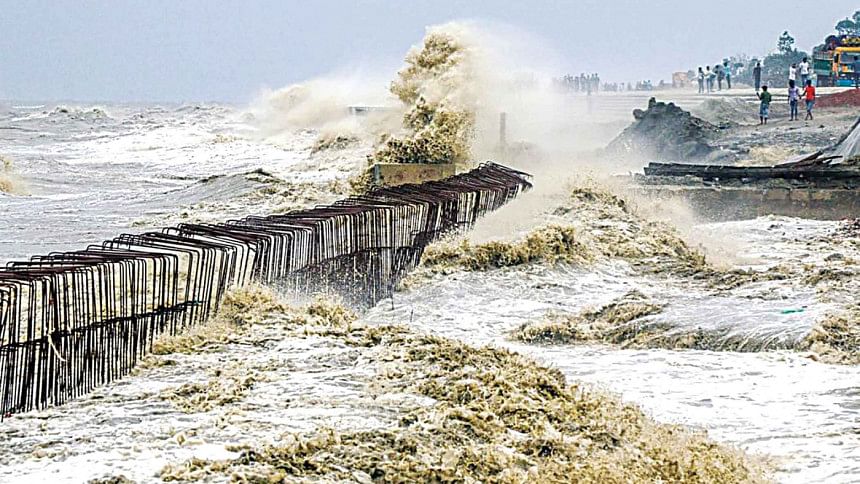Fifty years of disaster risk governance in Bangladesh

Bangladesh has been facing the challenges of disasters due to natural or anthropogenic causes for decades. Prior to independence, this part of land was recognised only as a poor and disaster-prone one. Without independence, the country would have never achieved the successes that it has today. Bangladesh has a dignified identity as a 'developing country'.
It is well-known that initiatives for managing disasters are intrinsically linked with independent Bangladesh. In this connection, we must acknowledge two significant speeches delivered by Bangabandhu Sheikh Mujibur Rahman in 1970, a year before independence. These were delivered in two consecutive months: on October 28 as part of a political campaign for his party Awami League and on November 26, after the devastating coastal cyclone (the Bhola cyclone of November 12) occurred. These two valuable deliberations of Bangabandhu were remarkable inspirations for the people of this land. Immediate after the cyclone, Bangabandhu rushed to the affected region suspending his election campaign, and mobilised all necessary support for the affected people, whereas the Pakistani rulers, at the same time, were busy plotting violent crimes against the innocent people of this land.
The speech of 26 November is considered as the foundation of disaster management in Bangladesh. Bangabandhu made disaster preparedness an integral part of the governance of the administration of independent Bangladesh formed under his leadership. One of the best examples of his disaster governance is inauguration of the Cyclone Preparedness Programme (CPP) in 1972. Higher grounds (popularly known as 'Mujib Killa') in flood plains were built to protect people and their livestock at that time. The independence of Bangladesh brought hope to all segments of the population, including a large number of freedom fighters, who returned with disabilities. In 1972 Bangabandhu formed the Ministry of Relief and Rehabilitation to address challenges of disasters. However, these early initiatives to manage disasters have not been followed by the successive governments. This was reflected in the lack of preparedness in managing two consecutive floods in 1987 and 1988 and the severe cyclone in 1991. The devastating nature of these two floods and casualties of the 1991 cyclone attracted international attention, and were revealed as examples of failure of disaster governance. It has been identified that massive destruction and death due to disasters in Bangladesh are not only related to her geographical settings but also due to attempts to 'control' disasters instead of 'managing' them. Relief distribution, structural solutions, and faulty constructions became concomitant with disaster management and continued for a long time.
In the attempts to reduce disaster risks, the concept of Disaster Risk Reduction (DRR) in Bangladesh brought about a paradigm shift from 'reactive relief-based measures to proactive integrated management approach'. Preparedness, mitigation, response and recovery have become an integrated part of DRR mechanisms in most of the disaster-prone countries. Different policies, legislations and frameworks were developed for achieving DRR goals across the world. The international commitments, such as the Yokohama Strategy and Plan of Action (1990-1999), which is considered as the first global strategy to address disasters and disaster risk management, were adhered to by Bangladesh. Disaster Management Bureau was established within this time period. Bangladesh was the first country within South Asia to develop the Standing Order on Disasters (SoD) in 1997.
The next remarkable development was the Hyogo Framework for Action (HFA, 2005 to 2015), aimed to promote DRR as a policy priority, stepping towards disaster risk governance. Countries began to take initiatives to build resilient nations and communities through identifying some gaps of Hyogo Framework for Action.
Based on the feedback from member countries of United Nations, Sendai Framework for Disaster Risk Reduction (2015-2030) was developed focusing on 'disaster resilience' ensuring adequate means of implementation. The scope of SFDRR in disaster-prone countries, including Bangladesh, has been extended through addressing environmental, technological and biological hazards and risks in addition to 'natural' and anthropogenic or human-induced hazards and disasters.
Comprehensive Disaster Management Programme (CDMP) was established with the support of development partners and was implemented in two phases. CDMP initiated professionalisation of disaster management. Disaster management has started to become institutionalised as part of academic disciplines in several universities. Over the last decades, a good number of institutional structures to achieve technical monitoring, capacity building, preparedness and response in reducing disaster risks have been initiated. The Ministry of Disaster Management and Relief (MoDMR), with the line agency, Department of Disaster Management (DDM), is coordinating national disaster management efforts across relevant ministries and agencies. The national DRR drivers are directed by Vision 2021 and 2041; Five Year Plans (the Seventh FYP first had a background document on DRR and climate change adaptation); Delta Plan 2100; and Transforming Our World: the 2030 Agenda for Sustainable Development (2016-2030) and SFDRR (2016-2030).
The major drivers on DRR in Bangladesh are the National Plan for Disaster Management (2010; revised in 2016-2020); Standing Orders on Disaster (developed in 1997; revised in 2010 and 2019); Disaster Management Act (2012); Disaster Management Policy (2015); National Earthquake Contingency Plan and some other relevant documents published by the DDM and MoDMR. The Ministry has taken initiatives keeping in mind Bangabandhu's thoughts and emphasising on both structural and non-structural DRR activities such as reviving and reconstructing 'Mujib Killa' in different disaster-affected regions, increasing number of cyclone and flood shelters, building houses, improving roads and communication networks and constructing disaster resilience houses for the vulnerable people to mark the birth centenary of the Father of the Nation.
Several other projects and programmes are in the process of implementation including National Resilience Programme (NRP), which focuses on inclusive resilience with special emphasis on gender and disability; Emergency Multi-Sector Rohingya Crisis Response project; a special programme for DRR and food security for pregnant and lactating mothers and children below five; and establishing a National Emergency Operation Center (NEOC). The revised SOD (2019) has, for the first time, included experts of several sectors to be nominated by the government such as water resources, climate change, earthquake, disaster management, gender and social inclusion among others in the National Disaster Management Advisory Committee (NDMAC). National Disaster Management Council (NDMC) is headed by the Honourable Prime Minister and includes ministers from 13 relevant ministries.
Identified as a 'role model' for disaster management, in the Mujibborsho the National Adaptation Center-Dhaka office has been established by UN (in 2020). In addition, Bangladesh has been selected to Chair (MoDMR) the prestigious Asian Disaster Preparedness Center (ADPC in 2021) among 24 member countries of ADPC. Bangladesh is also recognised as a pioneer in promoting gender and DRR agenda within South Asia and has received global recognition for gender mainstreaming efforts. The author has been internationally recognised for her three-decade-long contributions in pioneering gender and DRR issues to the national and international communities and continuing supporting the efforts of the government in achieving gender and social inclusion agenda.
Climate change is a major cause for the increasing intensity and frequency of disasters. Bangladesh has been playing a crucial role to raise its voice in climate change negotiations and taking initiatives to mitigate and adapt to the changing climate. Prime Minister Sheikh Hasina has been instrumental in taking initiatives to protect the environment, combat the negative consequences of climate change and reduce disaster risk. United Nations Environment Programme (UNEP) has honoured the Prime Minister as the 'Champion of the Earth' in Policy Leadership category for her proven leadership in addressing the impacts of climate change. She has also received many other global applauds for her dynamic leadership and efforts for empowering women. The most recent was achieved on International Women's Day (March 8, 2021), when Prime Minister Sheikh Hasina was acknowledged as one of the top three inspirational women leaders by the United Nations for demonstrating extraordinary leadership in managing the Covid-19 pandemic. The two other women leaders named are Prime Minister Jacinda Arden and Prime Minister Mia Amor Mottley. The UN Secretary-General Antonio Guterres referred to Bangladesh's Prime Minister as a committed leader to her people with special reference to her earlier efforts in reducing disaster risks.
It can be concluded that within the fifty years of independence, DRR in Bangladesh has been governed by strong institutional mechanisms. However, different lessons have been learned from cyclone Amphan and floods of 2020 during the pandemic, posing threats to the existing risk reduction initiatives. Amidst this pandemic, Bangladesh faced two disasters: cyclone Amphan and floods. Responding to these disasters was critically challenging for the country. Lessons learned from the cyclonic disaster during Covid-19, specifically on maintaining social distance, health hygiene and security in over-crowded cyclone shelters, need to be addressed within the changing policy environment. The MoDMR undertook an immediate decision to increase number of cyclone shelters turning academic institutions as temporary shelters, which remained closed due to the pandemic. However, there are many other lessons to be taken from these two disasters that occurred during the pandemic, which required timely and well-focused policy to address the vulnerabilities of disaster-affected people.
Mahbuba Nasreen is the Director & Professor of the Institute of Disaster Management and Vulnerability Studies, University of Dhaka, Bangladesh.
Email: [email protected]

 For all latest news, follow The Daily Star's Google News channel.
For all latest news, follow The Daily Star's Google News channel. 



Comments